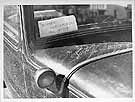
|
|
|

|

|

|

|
|
Click on an image to see a larger, more detailed picture.
|
|
|
|
|
| 1935: Steps Toward Destruction |

|
pg. 89 |

|
|
|
|
| |
 The Gestapo headquarters looms ominously on Prinz Albrechtstrasse in Berlin. A benign residence was transformed into a place of terror and torture after it was occupied by the notorious Gestapo. Germany's secret police used all methods available to wring information out of people. Individuals unfortunate enough to be introduced to the building's torture chambers and dungeons emerged battered and psychologically broken.
The Gestapo headquarters looms ominously on Prinz Albrechtstrasse in Berlin. A benign residence was transformed into a place of terror and torture after it was occupied by the notorious Gestapo. Germany's secret police used all methods available to wring information out of people. Individuals unfortunate enough to be introduced to the building's torture chambers and dungeons emerged battered and psychologically broken.
Photo: SYddeutscher Verlag Bilderdienst
|
 The Nazis went to great lengths to justify their "scientific" racism. This is a chart from Genetics and Racial Science: A Photographic Portrayal, one of numerous Nazi textbooks on the subject. The photographs are designed to show that the European racial type is aesthetically superior to the Australian, Negro, and Mongoloid races.
The Nazis went to great lengths to justify their "scientific" racism. This is a chart from Genetics and Racial Science: A Photographic Portrayal, one of numerous Nazi textbooks on the subject. The photographs are designed to show that the European racial type is aesthetically superior to the Australian, Negro, and Mongoloid races.
Photo: Library of Congress/United States Holocaust Memorial Museum Photo Archive
|
 Pro-Nazi Groups in U.S.
Pro-Nazi Groups in U.S.
The German-American Bund was the most consequential pro-Nazi political movement to emerge in the prewar United States. Under the leadership of its "Führer," a notorious antisemite named Fritz Kuhn, the Bund at its height claimed about 15,000 members in addition to 8000 Storm Troopers. A 1939 rally in New York City's Madison Square Garden attracted an audience of 20,000. In spite of efforts to portray themselves as patriotic Americans, even going so far as to combine images of George Washington and the swastika in their propaganda, Bundists were overwhelmingly German immigrants whose thoughts were with Nazi Germany. Membership was concentrated in large cities, and the party never had much grass-roots support. Never a serious threat to the American government, the Bund's fortunes experienced a downturn in 1939, when Kuhn was sent to prison for embezzling funds. Another avowedly antisemitic political movement to emerge between the wars was William Dudley Pelley's Silver Shirts. Pelley claimed that a "near-death experience" influenced his spiritualist antisemitism. Like the Bund, the Silver Shirts could never claim an extensive membership; they had only about 15,000 members, mostly middle-class, by 1934. The movement's strength dwindled to only 5000 four years later.
Photo: Library of Congress/United States Holocaust Memorial Museum Photo Archive
|
|

|

|

|

|
 1935: The first issue of the pseudoscientific, antisemitic Zeitschrift für Rassenkunde (Journal for Racial Science) is published.
1935: The first issue of the pseudoscientific, antisemitic Zeitschrift für Rassenkunde (Journal for Racial Science) is published.
|
 1935: The American Jewish Congress joins with the Jewish Labor Committee to form the Joint Boycott Council, aimed at German purveyors of goods and services.
1935: The American Jewish Congress joins with the Jewish Labor Committee to form the Joint Boycott Council, aimed at German purveyors of goods and services.
|
 1935: The Nazi government forces the closure of Masonic lodges across Germany.
1935: The Nazi government forces the closure of Masonic lodges across Germany.
|
 1935: Anti-Jewish riots occur across Romania.
1935: Anti-Jewish riots occur across Romania.
|
 1935: Poland adopts a new constitution that abolishes parliamentary democracy.
1935: Poland adopts a new constitution that abolishes parliamentary democracy.
|
 1935: America's pro-Nazi Silver Shirts political group merges with the Christian Party.
1935: America's pro-Nazi Silver Shirts political group merges with the Christian Party.
|
 1935: In Britain, the first issue of Sir Oswald Mosley's Fascist Quarterly is published.
1935: In Britain, the first issue of Sir Oswald Mosley's Fascist Quarterly is published.
|
 1935: The German government permits the publication of Martin Luther's On the Jews and Their Lies, in which Luther advocates a program to arrest Jews, expropriate them, force them into the kind of labor the government determines, and, finally, to exile or murder them.
1935: The German government permits the publication of Martin Luther's On the Jews and Their Lies, in which Luther advocates a program to arrest Jews, expropriate them, force them into the kind of labor the government determines, and, finally, to exile or murder them.
|
|
|
|
|
| 1935: Steps Toward Destruction |

|
pg. 89 |

|
|
The Holocaust Chronicle
© 2009 Publications International, Ltd.
|
|
